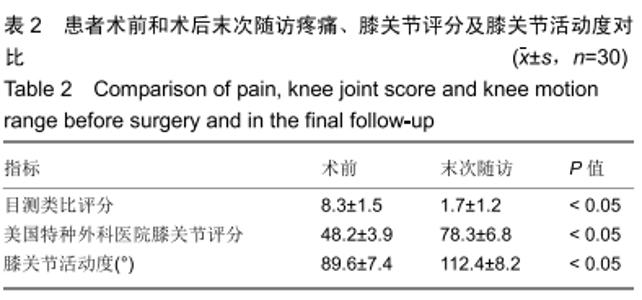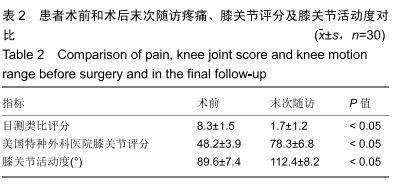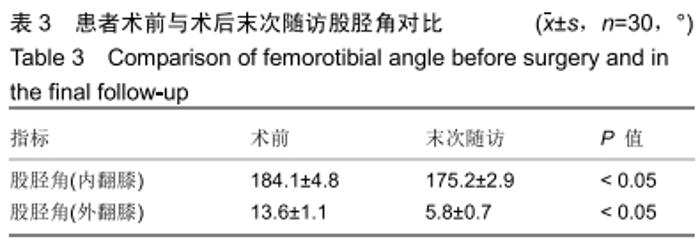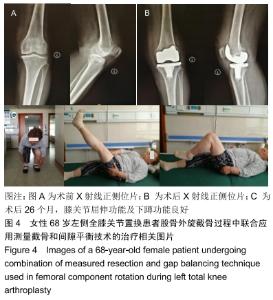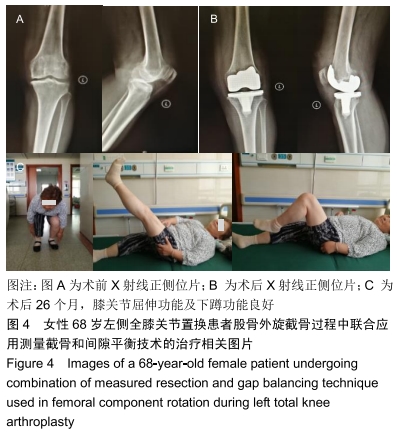[1] MOON YW, KIM HJ, AHN HS, et al. Comparison of soft tissue balanc-ing, femoral component rotation,and joint line change between the gap balancing and measured resection techniques in primary total knee arthroplasty: a meta -analysis. Medicine(Baltimore).2016;95(39):e5006.
[2] 黄菲,曲铁兵.关于当前人工膝关节假体设计的焦点与展望[J]. 中华关节外科杂志(电子版),2012,6(4):617-624.
[3] PATEL AR, TALATI RK, YAFFE MA, et al. Femoral componentrotation in total knee arthroplasty: an MRI-based evaluation of our options. J Arthroplasty. 2014;29: 1666-1670.
[4] JOHNSON DR, DENNIS DA, KINDSFATER KA, et al. Evaluation of total knee arthroplasty performed with and without computer navigation:a bilateral total knee arthroplasty study. J Arthroplasty.2013;28: 455-458.
[5] SEO J, MOON Y, KIM S, et al. Easy identification of mechanical axis during total knee arthroplasty. Yonsei Med J. 2013;54:1505.
[6] VANIN N, PANZICA M, DIKOS G, et al. Rotational alignment in totalknee arthroplasty: intraoperative inter-and intraobserver reliability of Whiteside’s line. Arch Orthop Trauma Surg.2011;131:1477 -1480.
[7] CINOTTI G, RIPANI FR, SESSA P, et al. Combining different rotational alignment axes with navigation may reduce the need for lateral retinacular release in total knee arthroplasty. Int Orthop.2012;36:1595-1600.
[8] MOON YW, KIM HJ, AHN HS, et al . Comparison of soft tissue balancing, femoral component rotation , and joint line change between the gap balancing and measured resection techniques in primary total knee arthroplasty : a meta-analysis. Medicine (Baltimore) . 2016; 95(39) : e5006.
[9] KONIGSBERG B, HESS R, HARTMAN C, et al. Inter- and intraobserver reliability of two-dimensional CT scan for total knee arthroplasty component malrotation. Clin Orthop Relat Res. 2014; 472(1): 212-217.
[10] SPRINGER BD, PARRATTE S, ABDEL MP. Measured resection versus gap balancing for total knee arthroplasty. Clin Orthop Relat Res. 2014;472(7): 2016-2022.
[11] KINZEL V, LEDGER M, SHAKESPEARE D. Can the epicondylar axis be defined accurately in total knee arthroplasty? Knee. 2005;12(4): 293-296.
[12] INSALL JN, BINAZZI R, SOUDRY M, et al. Total knee arthroplasty. Clin Orthop Relat Res. 1985; (192): 13-22.
[13] LEE JK, LEE S, CHUN SH, et al. Rotational alignment of femoral component with different methods in total knee arthroplasty: a ran-domized ,controlled trial. BMC Musculoskelet Disord. 2017;18(1) : 217.
[14] 宋兵华,孙俊英,倪增良,等.国人股骨远端旋转轴线的影像学研究及其临床意义[J].中国骨伤杂志, 2016, 29(1):41-47.
[15] 陈志伟,谭晶,崔俊成,等.个体化股骨后髁旋转截骨在人工全膝关节置换中的应用[J].中国骨与关节杂志, 2018,4(7): 251-255.
[16] 符得红,戴祝.全膝关节置换术中间隙平衡技术的应用进展[J].中国骨与关节损伤杂志, 2018,33 (4):446-448.
[17] CASTELLI CC, FALVO DA, IAPICCA ML, et al. Rotational alignment of the femoral component in total knee arthroplasty. Ann Transl Med. 2016; 4(1): 4.
[18] CROSS MB, NAM D, PLASKOS C, et al. Recutting the distal femur to increase maximal knee extension during TKA causes coronal plane laxity in mid-flexion. Knee. 2012;19(6): 875-879.
[19] KREUZER SW, POURMOGHADDAM A, LEFFERS KJ, et al. Computed to-mography analysis of postsurgery femoral component rotation based on a force sensing device method versus hypothetical rotational alignment based on anatomical landmark methods: a pilot study. Adv Orthop. 2016; 2016: 4961846.
[20] BABAZADEH S, DOWSEY MM, VASIMALLA MG, et al. Gap balancing sacrifices joint-line maintenance to improve gap symmetry: 5-year follow-up of a randomized controlled trial. J Arthroplasty. 2018;33(1): 75-78.
[21] 齐志远,陈秀民,王在斌,等.全膝关节置换术中测量截骨与间隙平衡截骨的疗效比较[J]. 中国骨与关节损伤杂志, 2017,32(2): 144-147.
[22] 洪伟祥,冯建民,王毅,等. 测量截骨与间隙平衡技术在全膝关节置换术中应用的中期随访比较[J].国际骨科学杂志, 2016, 37(4):255-259 .
[23] 潘永谦,李健,张平,等. CT扫描在全膝关节置换术中髌股关节轨迹不良股骨旋转力线的研究[J].中国矫形外科杂志,2014, 22(20):1895-1898.
[24] JABALAMELI M, MORADI A, BAGHERIFARD A, et al. Evaluation of distal femoral rotational alignment with spiral CT scan before total knee arthroplasty (a study in iranian population). Arch Bone Jt Surg. 2016; 4(2):122-127.
[25] CASTELLI CC, FALVO DA, IAPICCA ML, et al. Rotational alignment of the femoral component in total knee arthroplasty. Ann Transl Med. 2016; 4(1):4.
[26] 张闻,邵俊杰,张先龙.计算机导航对人工全膝关节置换术下肢旋转对线的影响[J].中华骨科杂志, 2008, 28(10):819-823.
[27] MANNAN A, SMITH TO. Favourable rotational alignment outcomes in PSI knee arthroplasty: A Level 1 systematic review and meta-analysis. Knee. 2016; 23(2):186-190.
[28] SHETH NP, HUSAIN A, NELSON CL. Surgical techniques for total knee arthroplasty: measured resection, gap balancing, and hybrid. J Am Acad Orthop Surg. 2017;25(7): 499-508.
|


